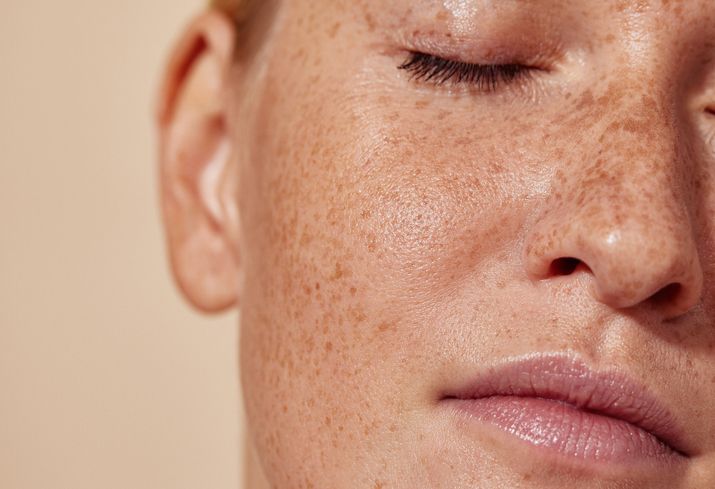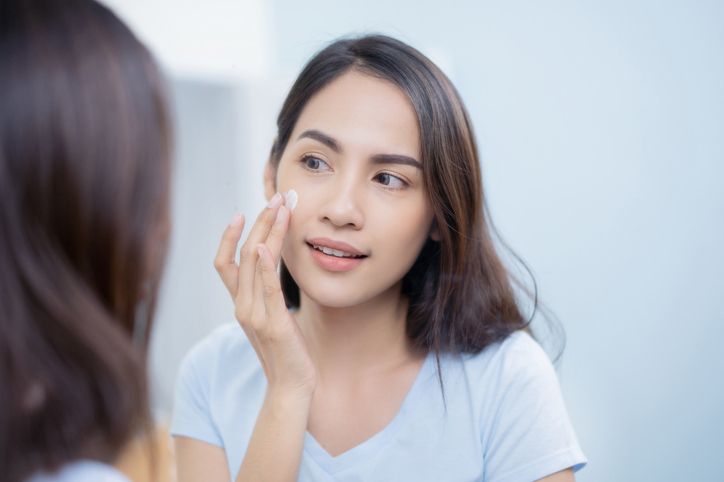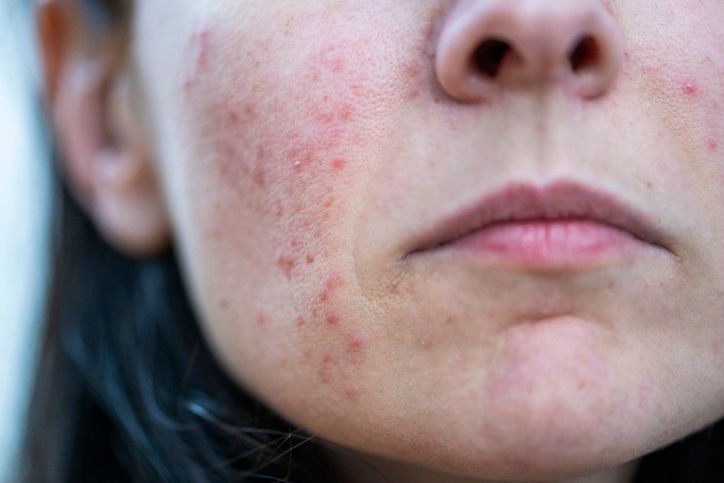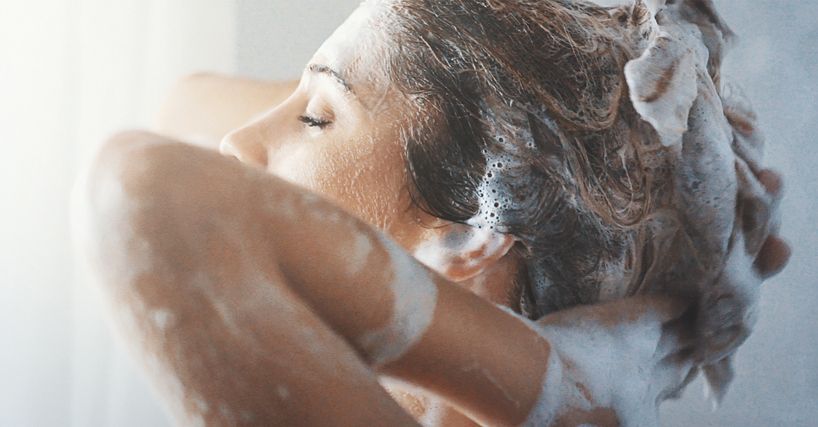Author: Natalie Ng|Updated: 19 June 2025
Freckles often appear after sun exposure, especially on light skin or sun-exposed areas like the cheeks and nose. These light brown spots form when pigment cells produce more melanin in response to UV rays. People with fair skin or blonde hair tend to develop freckles more easily, but darker skin types can also see changes in skin pigmentation. Unlike moles, freckles sit on the skin’s outer layer and often fade with less sun. But persistent freckles, sun spots, and other signs of sun damaged skin can last longer—especially with regular exposure to UV light or tanning beds. If you're looking for ways to fade freckles, improve skin tone, or reduce brown spots without affecting the surrounding skin, there are safe and effective options. From sunscreen to professional treatments, many methods can help lighten freckles gradually while supporting healthy skin texture. Scroll on to learn how to lighten freckles on face using dermatologist-approved treatments that work across different skin types.

What Causes Freckles and Why They Become Darker Over Time

Freckles form when the skin produces more melanin in response to UV light. These small brown spots usually appear on sun exposed areas like the face, arms, and shoulders. People with fair skin, light skin, or blonde hair tend to develop freckles more easily due to having less natural sun protection in the form of melanin.
Triggers for darker freckles
Freckles often appear in childhood but become more noticeable with increased sun exposure, especially without proper broad spectrum sunscreen use. Some key factors that make freckles darker or more persistent include:
• UV radiation from sunlight or tanning beds
• Not wearing sunscreen daily, particularly during high UV hours
• Exposure to direct sunlight without physical protection like hats or clothing
• Genetic factors, especially in people with lighter skin color
Unlike age spots or moles, freckles tend to fade with less sun. But repeated exposure can cause new freckles to appear and older ones to deepen in color. This is why daily sun protection and long-term freckle reduction strategies are necessary to keep the skin clear and even-toned.

Method 1: Broad Spectrum Sunscreen to Lighten Freckles and Prevent New Ones

Daily sun protection helps fade freckles
Freckles form when UV rays reach pigment cells in the skin’s outer layer. This causes melanin to build up, especially in sun-exposed skin like the cheeks, nose, and forehead. Light skin and fair complexion types often develop freckles faster, but darker skin types can be affected too. Without protection, new freckles, sun spots, and darker brown spots may appear and existing ones may deepen.
Build a routine that blocks UV rays
Apply a broad spectrum sunscreen with SPF 30 or higher every morning. Reapply every two hours when outdoors. Focus on areas that receive direct sunlight. This limits the skin changes caused by ultraviolet light and helps reduce sun damaged skin over time.
Key steps to follow:
• Use enough sunscreen to fully cover the face and neck
• Apply before sun exposure, not after you’re already outside
• Carry sunscreen with you for easy reapplication during the day
Add physical protection to reduce UV exposure
Cover skin with wide-brimmed hats, UV-blocking sunglasses, and long sleeves to reduce exposure during peak sunlight hours. Use physical sunscreens with zinc oxide or titanium dioxide. These ingredients sit on top of the skin and reflect UV rays before they reach pigment cells.
Include SPF in moisturizers and makeup to keep up protection throughout the day. These layers help protect sensitive skin, support freckle reduction, and prevent changes in skin tone and skin texture.
Read More
Book Now to Experience
PicoCure Pigmentation Removal Treatment
1 Minute Self-Registration
Date should not be before minimal date

Method 2: Vitamin C Serums to Lighten Freckles and Even Skin Tone
Correct application improves results
Vitamin C serums can help lighten freckles by reducing melanin production and protecting skin from sun damage. Apply a few drops to clean, dry skin every morning before moisturizer and sunscreen. For best results, choose a serum containing L-ascorbic acid at a concentration of 10–20%. Store the bottle in a dark, cool place to avoid oxidation. If the serum turns yellow or brown, it's time to replace it—usually every 3 to 6 months.
Application steps for best absorption
To protect your skin barrier and improve how well the product works:
• Cleanse your face thoroughly with a gentle, pH-balanced cleanser
• Pat your skin dry completely
• Dispense 3–4 drops of vitamin C serum onto your fingertips
• Press the serum into your skin using upward motions
• Wait 3–5 minutes for full absorption before applying other skincare products
• Always follow with a broad spectrum sunscreen during the day
Benefits for freckles and hyperpigmentation
Vitamin C works at multiple levels to fade freckles and improve skin tone. It starts by interrupting melanin production, which helps prevent new freckles from forming. Most people see this effect within 2 to 4 weeks of regular use. Over the next several weeks, vitamin C supports collagen production, which helps smooth out skin texture and improve uneven skin tone. This becomes noticeable around the 4 to 8-week mark.
At the same time, vitamin C provides immediate antioxidant protection. This helps shield the skin from UV damage, which reduces the risk of new freckles and sun spots. These combined effects not only target freckles but also address other types of skin pigmentation, supporting a brighter and more even complexion with consistent use over 8 to 12 weeks.

Method 3: Chemical Exfoliants and Retinoids to Fade Freckles Through Skin Cell Turnover
Exfoliants remove damaged surface skin
Chemical exfoliants break down the bonds between dead skin cells in the skin's outer layer. This helps reveal newer skin beneath and gradually fades freckles. Alpha-hydroxy acids (AHAs) like glycolic acid and lactic acid work on the surface to improve skin tone by dissolving old, pigmented cells. Beta-hydroxy acids (BHAs), such as salicylic acid, go deeper into the pores to address pigmentation at the source and help clear sun damaged skin.
By increasing skin cell turnover, these ingredients reduce the appearance of light brown spots and improve overall skin texture. Regular use helps lighten freckles and other sun-related pigmentation without affecting the surrounding skin.
Retinoids improve pigment distribution and boost collagen
Retinoids are vitamin A derivatives that convert into retinoic acid once absorbed. They stimulate collagen production, fade darker brown spots, and help redistribute melanin more evenly across the skin. This makes them especially useful for deeper pigmentation and stubborn freckles that don't respond to surface exfoliation alone.
Combination routines for improved results
Using exfoliants and retinoids together can improve outcomes, but it’s important to introduce them slowly:
• Start with lower concentrations to avoid irritation
• Use exfoliants and retinoids on alternating nights
• Always apply a broad spectrum sunscreen during the day
• Avoid direct sunlight after application to protect lightened areas
• Give your skin time to adjust before increasing usage
This method helps remove freckles gradually while supporting the skin’s natural renewal cycle.
Book Now to Experience
PicoCure Pigmentation Removal Treatment
1 Minute Self-Registration
Date should not be before minimal date

Method 4: Plant-Based Ingredients to Lighten Freckles Gently
Natural extracts target pigmentation over time
Gentle freckle reduction is possible using natural ingredients that help fade pigmentation without irritating the skin. These plant-based solutions are often used as alternatives to chemical treatments and can support freckle reduction when used regularly alongside sun protection.
Common ingredients that help fade freckles
• Lemon juice contains natural citric acid and vitamin C, which can reduce melanin production and brighten sun-exposed skin. Apply diluted lemon juice to freckled areas using a cotton ball, and rinse after a few minutes to avoid irritation.
• Aloe vera supports skin renewal through its natural compounds that promote cell turnover. Apply fresh aloe gel directly from the plant or use pure aloe vera products to help reduce pigmentation and improve skin texture.
• Licorice root extract includes glabridin, a compound that helps lighten freckles by limiting melanin production and calming inflammation. Look for products that list licorice extract high in the ingredient list.
• Papaya enzymes naturally exfoliate the skin and can help fade darker brown spots. You can use mashed ripe papaya as a mask or choose skincare products that contain papain for gradual brightening.
Patch testing and sun protection
Before using any new natural ingredient, apply a small amount to a discreet area of skin and wait 24 hours to check for sensitivity or allergic reaction. Always wear broad spectrum sunscreen during the day while using these ingredients, as they can increase your skin’s sensitivity to UV rays and reverse progress if exposed to direct sunlight.

Method 5: Chemical Peels Performed by Professionals to Fade Stubborn Freckles
Deeper exfoliation for more visible pigmentation
Professional chemical peels use controlled concentrations of acid to remove the skin’s outer layers. This process targets freckles that sit deeper within sun damaged skin and encourages the growth of new, evenly pigmented skin cells. Chemical peels are often recommended for people with fair skin, but medium peels may be used on darker skin types with careful supervision.
What to expect during the procedure
• Your skin is thoroughly cleansed and prepped with a special solution to help the peel absorb evenly
• A chemical solution is applied in layers to target areas with freckles and light brown spots
• A mild tingling or warming sensation may occur as the solution works on breaking down excess pigmentation
• The peel is neutralized after a set time, and your skin may begin to flake or peel over the following days
This treatment removes pigment-heavy cells and encourages skin renewal. As the skin heals, freckles fade and the skin tone becomes more even.
Aftercare and results
Following the procedure, your skin may be red and more sensitive than usual. Your dermatologist will provide specific aftercare instructions, which often include:
• Avoiding direct sunlight and excessive sun exposure
• Applying healing creams and using gentle cleansers
• Protecting the skin daily with SPF 30+ broad spectrum sunscreen
Results become more noticeable as peeling completes, usually within one to two weeks. Multiple sessions may be needed depending on skin pigmentation depth and desired outcome. Proper care between treatments is important to maintain results and prevent new freckles from forming.
Book Now to Experience
PicoCure Pigmentation Removal Treatment
1 Minute Self-Registration
Date should not be before minimal date

Method 6: Laser Treatments to Remove Freckles and Improve Skin Tone
Two types of laser therapy target freckles at different depths
Laser treatments offer a focused approach to freckle removal by using light energy to break down melanin in the skin. The two most common options are IPL (Intense Pulsed Light) and fractional lasers. Both methods help fade existing freckles and reduce the risk of new ones forming in sun exposed areas.
• IPL treatments use pulses of broad-spectrum light to target surface pigmentation. This method works well for lighter freckles and larger treatment areas like the face or shoulders.
• Fractional lasers reach deeper into the skin, targeting more stubborn freckles and darker brown spots with greater precision. These lasers create microscopic columns in the skin, triggering pigment breakdown and stimulating skin cell turnover.
Recovery and results after treatment
The recovery time and treatment schedule vary depending on the method used:
• IPL typically requires 3 to 5 sessions spaced 3 to 4 weeks apart. Redness may last 1 to 2 days, but there is little to no downtime.
• Fractional laser treatments are more intense. You may need only 1 to 2 sessions, but recovery can take 5 to 7 days due to redness, swelling, and temporary skin sensitivity.
Freckles may appear darker for a few days after each session before they begin to fade. Complete results often develop over 2 to 3 months.

Method 7: Microdermabrasion to Smooth Skin and Minimize Freckles
Exfoliates the skin’s surface to reduce pigmentation
Microdermabrasion is a non-invasive treatment that helps fade freckles by removing the skin’s outer layer where excess pigment builds up. The procedure uses a handheld device that sprays fine crystals onto the skin while vacuuming them away at the same time. This action exfoliates dead skin cells, supports skin cell turnover, and reveals fresher, more evenly toned skin.
What happens during treatment
Each session follows a straightforward process:
• The skin is first cleansed to remove oil and surface buildup
• A microdermabrasion device is used to gently exfoliate targeted areas with freckles
• Dead skin cells are removed, and blood flow to the skin increases, which supports new cell growth
• The skin may feel slightly warm or tight afterward, with visible smoothness immediately
Practitioners often focus on areas with concentrated freckles, such as the cheeks or nose. Because the treatment is gentle, it can be safely repeated over several sessions to gradually reduce pigmentation while improving overall skin texture.
Post-treatment care and results
Most people return to normal activities right after the procedure. Some mild redness or dryness may occur but usually resolves within a few hours.
• Avoid sun exposure for several days to protect newly exfoliated skin
• Apply moisturizer to support healing and comfort
• Use SPF 30+ daily to maintain results and avoid new freckles from UV rays
While microdermabrasion does not remove freckles permanently, it helps fade their appearance over time.
Book Now to Experience
PicoCure Pigmentation Removal Treatment
1 Minute Self-Registration
Date should not be before minimal date

Method 8: Prescription Creams to Lighten Freckles and Target Dark Spots
Stronger formulations for deeper pigmentation
Prescription skin-lightening creams offer a targeted approach to reduce freckles and improve uneven skin color. These products contain active ingredients like hydroquinone, kojic acid, or azelaic acid, which interfere with melanin production at the cellular level. When applied regularly, they help fade persistent freckles, lighten dark patches, and support a more even skin tone.
These creams are especially useful for individuals with sun damaged skin or freckles that have not responded well to over-the-counter treatments. Dermatologists adjust the strength and formula depending on your skin type, skin color, and how deep the freckles are in the skin’s layers.
Application guidelines and treatment plan
To avoid irritation and protect surrounding skin:
• Apply a thin layer of the cream directly to areas with freckles on clean, dry skin
• Avoid applying it to the entire face unless instructed, especially if you have sensitive skin
• Use the treatment at night or as directed by your dermatologist
• Always follow with SPF 30+ sunscreen during the day, as lightening agents can increase UV sensitivity
Most treatments require 8 to 12 weeks of regular use before visible improvement. Some people may need longer depending on how their skin reacts.

Method 9: Spot Treatments to Fade Individual Freckles Without Affecting Surrounding Skin
Focused application for precise freckle reduction
Targeted spot treatments offer a precise way to reduce freckles without lightening the surrounding skin. These products contain concentrated active ingredients that help break down melanin in specific areas. They’re especially useful for isolated freckles or darker brown spots that haven’t faded with broader treatments.
Spot treatments come in different forms such as gels, serums, and creams. The active ingredients may vary, but common ones include:
• Vitamin C and ferulic acid, which brighten sun spots and protect against UV damage
• Kojic acid and arbutin, which reduce pigmentation in darker freckles
• Niacinamide and alpha arbutin, which help fade deep freckles and improve skin texture
Application technique and treatment timeline
Apply a small amount of product directly onto each freckle using clean fingertips or a cotton swab. Consistency is important—most treatments are used once or twice a day.
To avoid irritation and get better results:
• Start with a lower concentration to check your skin’s reaction
• Apply only to the freckled areas to avoid uneven skin color
• Use gentle products around sensitive skin areas like the nose or under the eyes
• Always follow with broad spectrum sunscreen to protect treated spots from UV light
With regular use, targeted spot treatments can reduce the appearance of persistent freckles and blend them more evenly into your skin tone over several weeks.

Bonus Method: PicoCure Laser Treatment to Remove Freckles at the Root
Freckles caused by sun exposure can be difficult to fade completely, especially if they sit deep within the skin or have darkened over time. While topical products and home treatments help lighten freckles on the surface, deeper pigmentation often needs targeted technology. This is where PicoCure Pigmentation Removal Treatment comes in.
PicoCure is a non-invasive laser treatment designed to treat a wide range of pigmented skin concerns, including light brown spots, sun spots, and age-related freckles. It uses a combination of picosecond and nanosecond laser energy at four different wavelengths to break down pigment in all layers of the skin, without damaging surrounding skin. The laser energy travels so quickly that it targets melanin deposits in a fraction of a second, reducing risks of overheating or rebound pigmentation.
How PicoCure helps lighten freckles
• Targets all pigment levels: PicoCure’s laser energy reaches both deep and surface-level pigmentation, helping to fade freckles, lighten dark patches, and even out your overall skin tone.
• Improves skin texture: The treatment stimulates collagen production, which supports smoother skin and reduces the appearance of pores and fine lines.
• Reduces risk of irritation: Because the energy doesn’t linger in the skin, it’s suitable for sensitive skin and darker skin types, with less risk of burns or rebound pigmentation.
• No downtime: The treatment requires no recovery period, so you can return to your regular routine right away—making it ideal for those with a busy schedule.
By breaking down pigment more completely than surface treatments, PicoCure can help address freckles that haven’t responded to other methods. It also improves skin quality overall, helping you achieve a brighter complexion with a more even skin tone.
Ready to target freckles at the source and restore clearer, smoother skin? Book your PicoCure Pigmentation Removal Treatment today.
New Beauty's PicoCure Pigmentation Removal TreatmentBook Now to Experience
PicoCure Pigmentation Removal Treatment
1 Minute Self-Registration
Date should not be before minimal date
FAQ
Can freckles go away without treatment?
Freckles may fade over time, especially during months with less sun exposure, but they rarely disappear completely without help. The skin's natural cell turnover can reduce pigmentation slightly, particularly in people who avoid UV rays and wear broad spectrum sunscreen daily. For persistent freckles, treatments like laser therapy, topical creams, or chemical peels are usually needed to achieve visible lightening.
Does lightening freckles affect my skin’s natural color?
Freckle removal treatments aim to target excess melanin without changing your overall skin color. When used correctly, products and procedures should lighten freckles and dark spots while preserving the surrounding skin. It’s important to follow instructions carefully, especially for darker skin types, as overuse of strong ingredients may cause uneven skin tone or temporary light patches.
Are fake freckles safe for skin?
Fake freckles created using makeup or semi-permanent products are generally safe for most skin types, as long as the formulas are non-comedogenic and free of irritating ingredients. If you’re using tint pens or freckle tattoos, make sure they’re designed for use on the face. People with sensitive skin should patch test first to avoid reactions. Unlike sun-induced freckles, fake freckles don’t involve UV exposure and won’t increase skin pigmentation.
Can diet or supplements help fade freckles naturally?
While no food can directly remove freckles, certain nutrients may support healthier skin and reduce UV-related pigmentation. Vitamins like C and E, along with antioxidants such as beta-carotene, can strengthen skin’s defense against sun damage. Staying hydrated and eating foods rich in skin-repairing nutrients may support overall skin tone and improve the appearance of sun damaged skin over time.
Do freckles mean I have sun damaged skin?
Freckles are one of the earliest visible signs of sun exposure, especially in people with fair skin or light brown complexions. While they aren’t harmful, their presence may indicate that the skin has absorbed more UV radiation than it can safely handle. Over time, excessive sun exposure can lead to more permanent changes like age spots, uneven skin texture, and a higher risk of developing deeper pigmentation problems. Using sunscreen daily helps protect skin from further UV damage and prevents new freckles from forming.
Recommended Articles
COPYRIGHT© NEW BEAUTY MANAGEMENT LIMITED 2025. ALL RIGHT RESERVED.




